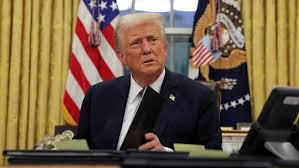Trump imposes 50% tariffs on copper, says pharma tariffs could reach 200%

In a move that could reshape global trade dynamics, former U.S. President Donald Trump — now poised for a possible return to the White House — announced a sweeping 50% tariff on copper imports, while also threatening a staggering 200% tariff on pharmaceutical products entering the U.S. market. The announcements, made on July 8, 2025, sent ripples through commodity markets and triggered strong reactions from major trade partners, including India, Japan, and the European Union.
This escalation follows Trump’s recent declaration that August 1 will be the final deadline for negotiating new trade agreements, indicating there will be “no extensions and no exemptions.” The aggressive stance is already fueling economic uncertainty and mounting pressure on foreign governments and multinational corporations.
A Shockwave in the Metals Market
The 50% copper tariff — effective immediately — marks one of the most drastic trade interventions in recent years. Copper, a critical raw material for everything from electric vehicles to electrical wiring, is seen as a backbone of modern infrastructure. Within hours of the announcement, U.S. copper futures surged nearly 13%, the biggest single-day gain in more than five decades.
Trump justified the decision under Section 232 of the Trade Expansion Act, citing national security concerns and the need to boost domestic production capacity.
“We’re going to rebuild America’s supply chains and stop relying on adversarial nations,” Trump stated during a campaign-style address. “Copper is too strategic to be outsourced.”
Analysts warn that the tariff could raise manufacturing costs across multiple sectors, including green energy, telecommunications, and construction — particularly at a time when the Biden administration’s clean energy investments were beginning to gain traction.
Pharma in the Crosshairs
Even more alarming to many global exporters is Trump’s proposed 200% tariff on pharmaceutical imports, which he claimed would come into force after an 18-month transition period. The pharmaceutical threat stems from a Department of Commerce investigation launched in April 2025, also under Section 232, examining whether U.S. dependence on foreign drug imports poses a national security threat.
While the results of the probe are due later this month, Trump made it clear he expects action.
“Big Pharma has been outsourcing for too long,” Trump said. “We will reclaim our pharmaceutical sovereignty — whatever it takes.”
This move targets countries like India, which is among the largest exporters of generic medicines to the United States, accounting for roughly 40% of U.S. generic drug demand. Indian industry insiders fear the tariff could cripple smaller pharma firms and disrupt the global supply chain for critical medications.
India and Global Reactions
India’s Commerce Ministry reacted swiftly, calling the copper tariff “disruptive” and the pharma warning “alarming.” According to ministry data, India exported around $360 million worth of copper and $9.8 billion in pharmaceutical products to the U.S. in the last fiscal year. The U.S. remains India’s largest export market.
New Delhi is reportedly considering approaching the World Trade Organization (WTO) if the pharma tariffs materialize, though diplomatic officials hope a bilateral trade deal can be reached before the August 1 deadline.
Elsewhere, Australia, Japan, South Korea, and the EU have called for “clarity” and “restraint.” Australia’s Trade Minister labeled the pharma threat as “deeply concerning,” and urged the U.S. to avoid policies that could jeopardize global health equity.
Political Strategy or Economic Reform?
Critics argue Trump’s moves are as much about campaign optics as they are about economics. With the U.S. election just months away, Trump is leaning into his “America First” platform, framing tough trade policies as essential for job creation and national resilience.
Some economists, however, warn that such policies could backfire. “These tariffs may provide a short-term boost to domestic producers, but they also risk inflation and retaliation,” said Dr. Karen Liu, a trade policy expert at Columbia University. “If countries hit back with their own tariffs, we could see another wave of global trade disruptions.”
Still, Trump appears undeterred. Sources inside his transition team say more tariff announcements could come by mid-July — particularly targeting electronics, automobiles, and even agricultural products.
Market Reactions Mixed
While copper markets reacted dramatically, U.S. equities remained relatively stable. The Dow Jones dipped slightly, while the S&P 500 and Nasdaq held their ground. Investors, it seems, have grown somewhat accustomed to Trump’s aggressive rhetoric and are waiting to see how much of it translates into enforceable policy.
However, currency markets did respond, with the Indian Rupee weakening slightly against the U.S. Dollar amid trade uncertainty. Pharma stocks in Mumbai took a hit, with several generic drug manufacturers seeing declines of 3–5% in early trading.
Looking Ahead
With less than a month remaining until Trump’s August 1 trade deadline, pressure is building on America’s top trading partners to strike deals — or face steep tariffs. The administration has already sent formal letters to at least 20 countries, laying out new trade terms and demanding compliance or concessions.
The current wave of tariffs — and threats of more — marks a major pivot in global trade. Whether it will lead to stronger domestic industries or a new era of trade wars remains to be seen.
What is clear, however, is that Trump’s strategy is reshaping the rules of global commerce — and the consequences could last long beyond Election Day.






